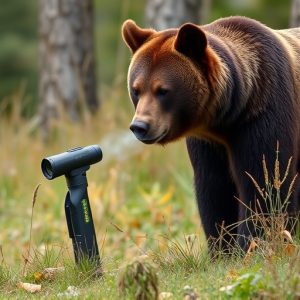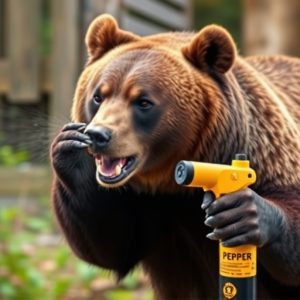Mastering Bear Spray Fogger Defense: Cloud Dispersal & Optimal Use
Bear spray foggers use advanced nozzles and pressurized containers to emit a pepper spray cloud that…….
Bear spray foggers use advanced nozzles and pressurized containers to emit a pepper spray cloud that can cover up to 30 feet, deterring bears without harm. The dispersal range is influenced by nozzle design, wind, terrain, and temperature/humidity. Optimal placement is at eye level on trails and camping grounds. Safe usage involves reading instructions, maintaining distance, aiming for the face and eyes, and moving away if sprayed. Understanding the 3-4 meter cloud dispersal range is crucial for evaluating effectiveness against different bear species, with direct spraying creating a stronger barrier. Following manufacturer guidelines ensures optimal results during bear encounters.
“In the rugged landscapes of Alaska, encountering bears is a reality for outdoor enthusiasts and residents alike. Understanding the power of bear spray foggers is essential for navigating these encounters safely. This article delves into the technology behind these defensive tools, exploring key factors that influence their dispersal range. We’ll uncover optimal deployment strategies for maximum protection and guide users on safety measures during use. Additionally, we’ll assess the effectiveness of bear spray against various species, providing a comprehensive resource for those seeking to guard against potential threats in Alaska’s wild environments.”
- Understanding Bear Spray Fogger Technology
- Key Factors Influencing Bear Spray Cloud Dispersal Range
- Optimal Deployment Scenarios for Maximum Protection
- Safety Measures and Best Practices During Use
- Evaluating the Effectiveness of Bear Spray against Different Bear Species
Understanding Bear Spray Fogger Technology
Bear spray foggers utilize cutting-edge technology to create a powerful defense mechanism against potential bear attacks. The core innovation lies in the dispersion range and efficiency of the bear spray cloud. These devices emit a fine mist or fog of pepper spray, designed to cover a wide area and reach bears at various distances. The advanced nozzles and pressurized containers ensure consistent and precise distribution of the spray, maximizing its effectiveness.
The technology behind these foggers allows for controlled release, ensuring that the spray doesn’t simply blow away in the wind but remains suspended in the air, creating a protective barrier around the user. This is crucial for off-trail activities in Alaska’s vast wilderness where bears roam freely. With a range of up to 30 feet (or more, depending on the model), these devices offer a safe and non-lethal way to deter aggressive bears, providing peace of mind for outdoor enthusiasts and residents alike.
Key Factors Influencing Bear Spray Cloud Dispersal Range
Several key factors significantly influence the dispersal range of a bear spray cloud. Firstly, the can’s nozzle design plays a crucial role in determining how far and wide the spray pattern extends. Nozzles with wider or more specialized patterns can cover larger areas but may not project as far as those with narrower, focused streams. Wind conditions are another critical element; an optimal breeze aids in dispersing the spray more evenly and over greater distances compared to still air or strong gusts that can cause erratic movement of the cloud.
Terrain also has a notable impact on bear spray cloud dispersal. In open areas, the spray can travel farther before dissipating due to lack of obstruction. Conversely, in dense forests or mountainous landscapes, the cloud may be constrained by trees or peaks, respectively, resulting in reduced range and more localized coverage. Additionally, temperature and humidity levels affect the spray’s density and persistence, with warmer, drier conditions generally allowing for longer-lasting and farther-reaching clouds.
Optimal Deployment Scenarios for Maximum Protection
When it comes to optimal deployment, timing is key for maximum protection against bears. The ideal scenario involves strategically positioning the bear spray fogger in areas where unexpected bear encounters are most probable. This could include trails, camping grounds, or along perimeter fences of remote cabins or outdoor recreational facilities.
The powerful cloud dispersal range of bear spray means it’s crucial to place the device at a height offering maximum coverage. Bear spray is most effective when bears are caught off guard and unable to avoid the fogged area. So, placing the foggers at eye level or slightly elevated can significantly enhance their protection capabilities in the right conditions.
Safety Measures and Best Practices During Use
When using a bear spray foger for defense, safety is paramount. Always read and understand the product’s instructions before deployment to ensure optimal effectiveness and personal safety. Maintain a safe distance from bears—at least 20 feet (6 meters)—and never approach or corner an aggressive bear. Aim for the bear’s face and eyes, creating a dense cloud of spray with a range of up to 30 feet (9 meters), covering both you and any potential escape path. Keep moving if sprayed, away from the bear, to reduce inhalation risks, and seek immediate medical attention if needed after exposure.
Evaluating the Effectiveness of Bear Spray against Different Bear Species
When it comes to evaluating the effectiveness of bear spray against different bear species, understanding the cloud dispersal range is crucial. Bear spray creates a fog-like cloud that can deter bears, but its impact varies based on factors like the distance between the user and the bear, wind conditions, and the specific bear species. For instance, black bears are generally more sensitive to the spray’s irritants compared to grizzly bears (brown bears). The cloud dispersal range—typically around 3-4 meters (10-13 feet) in ideal conditions—is close enough for bear spray to be effective against both types, but it must be used judiciously.
In terms of bear spray cloud dispersal range, the method of application also plays a role. Direct spraying into the face or eyes can create a more potent barrier, while misting or blowing the spray can have a less concentrated effect. Given these nuances, users should always follow manufacturer guidelines and local recommendations for the best results when facing potential bear encounters.
Alaska’s rugged terrain demands effective bear defense strategies, making bear spray foggers a valuable tool. By understanding the technology behind these devices, their optimal deployment scenarios, and safety best practices, users can maximize protection in various settings. Key factors like wind direction and fogger placement significantly influence the bear spray cloud dispersal range, ensuring targeted coverage. Moreover, evaluating the effectiveness against diverse bear species underscores the importance of choosing the right product for comprehensive security in Alaska’s wild landscapes.


